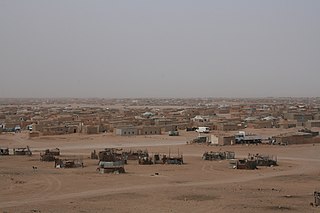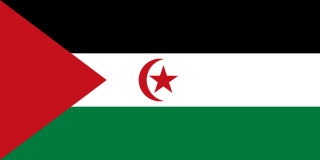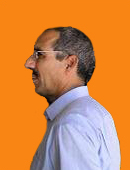Related Research Articles

The Polisario Front, Frente Polisario, Frelisario or simply Polisario, is a rebel Sahrawi nationalist liberation movement claiming Western Sahara.
Sahrawi Youth Union, also known by its Spanish acronym UJSARIO, is the youth organization of the Polisario Front.

The National Union of Sahrawi Women is the women's wing of the Polisario Front. It was created in 1974, and claims to have 10,000 members, divided between the Sahrawi refugee camps, the Liberated territories, the Moroccan-occupied part of Western Sahara and the Sahrawi diaspora.

Sahrawi Trade Union, also known as UGTSARIO, is the labor organization of the Polisario Front.

Tifariti is an oasis town and the temporary capital of the Sahrawi Arab Democratic Republic, located in north-eastern Western Sahara, east of the Moroccan Berm, 138 km (86 mi) from Smara and 15 km (9 mi) north of the border with Mauritania. It is part of what Polisario Front calls the Liberated Territories and Morocco call the Buffer Zone. It has been the de facto temporary capital of the Sahrawi Arab Democratic Republic since the government moved there in 2008 from Bir Lehlou. It is the headquarters of the 2nd military region of the SADR.

Mahfoud Ali Beiba Hammad Dueihi was a Sahrawi politician and co-founder of the Polisario Front, a national liberation movement that seeks self-determination for Western Sahara. From 1975 until his death, he lived in an exile in the refugee camps of Tindouf, Algeria.

The Government of Morocco sees Western Sahara as its Southern Provinces. The Moroccan government considers the Polisario Front as a separatist movement given the alleged Moroccan origins of some of its leaders.

The Sahrawi National Council or Sahrawi Parliament is the legislature of the Sahrawi Arab Democratic Republic. Its structure and competences are guided by the Constitution of the Sahrawi Arab Democratic Republic (SADR). The present speaker since 2020 is Hamma Salama.

The Sahrawi refugee camps, also known as the Tindouf camps, are a collection of refugee camps set up in the Tindouf Province, Algeria in 1975–76 for Sahrawi refugees fleeing from Moroccan forces, who advanced through Western Sahara during the Western Sahara War. With most of the original refugees still living in the camps, the situation is among the most protracted in the world.
Najm Allal is a singer, guitarist and writer of lyrics in Spanish from Western Sahara.

Operation Rattle, also known as the 1991 Tifariti offensive, was the last military operation in the Western Sahara War by the Royal Moroccan Army against the Polisario Front, seeking independence for Western Sahara. A ceasefire had been agreed between the parts on July. During August and the first days of September 1991, the Royal Moroccan Army (RMA) conducted offensive operations in the areas of Mehaires, Tifariti, Bir Lahlou, Mijek and Agwanit, resulting in multiple Sahrawi civilian casualties, the destruction of Tifariti and Bir Lahlou, poisoning of the wells and subsequently depopulation of the area.

Brahim Ghali is a Sahrawi politician, military officer and current president of the Sahrawi Arab Democratic Republic (SADR), formerly its ambassador to Algeria and Spain.

Aliyen Habib Kentaui is the Polisario Front representative for Sweden.

Mexico–Sahrawi Republic relations are the current and historical relations between Mexico and the Sahrawi Arab Democratic Republic (SADR). Mexico recognized the SADR on 8 September 1979.

The Sahrawi Arab Democratic Republic, also known as the Sahrawi Republic and Western Sahara, is a partially recognized state, recognised by 46 UN member states and South Ossetia, located in the western Maghreb, which claims the non-self-governing territory of Western Sahara, but controls only the easternmost one-fifth of that territory. Between 1884 and 1975, Western Sahara was known as Spanish Sahara, a Spanish colony. The SADR is one of the two African states in which Spanish is a significant language, the other being Equatorial Guinea.

Luchaa Mohamed-Lamin, also known as Obeid Luchaa was a Sahrawi politician, diplomat and co-founder of the Polisario Front, a national liberation movement that seeks self-determination for Western Sahara. One of his daughters is Nadhira Mohamed, who was the protagonist of the Spanish film Wilaya.

Sahrawi Arab Democratic Republic–Spain relations are the current and historical relations between the Sahrawi Arab Democratic Republic and Spain.

Jira Bulahi Bad is a Sahrawi engineer, politician, and activist. She is the representative of the Polisario Front in Spain since 2016.
Sahrawis have been present in Spain since the Spanish colonisation of Western Sahara. The specific number of Spaniards of Sahrawi origin is unknown due to the fact that the Spanish government does not collect data on ethnicity or racial self-identification, together with Spain not recognising Sahrawi nationality documents from the largely unrecognised Sahrawi Arab Democratic Republic.
Najla Mohamed-Lamin is a Sahrawi human rights activist and teacher who focuses on women's rights and environment issues. She established the Almasar Library Centre, which educates women and children living in Sahrawi refugee camps about climate change.
References
- 1 2 3 Cinema of the Arab World : contemporary directions in theory and practice. Ginsberg, Terri., Lippard, Chris. Cham: Palgrave Macmillan. 2020. ISBN 978-3-030-30081-4. OCLC 1144896441.
{{cite book}}: CS1 maint: others (link) - 1 2 Ginsberg, Terri; Lippard, Chris. Historical dictionary of Middle Eastern cinema (Second ed.). Lanham. ISBN 978-1-5381-3905-9. OCLC 1141042069.
- ↑ "Wilaya". City Libraries, City of Gold Coast. Retrieved 2021-01-10.
- 1 2 3 Jose, J. L. P. (2012-05-07). "LA Historia Personal de Nadhira Mohamed, Hija de un Jefe del Frente Polisario y Protagonista de "Wilya"". No Solo Cine (in Spanish). Retrieved 2021-01-10.
- 1 2 Babativa, David. "40 Años del Frente Polisario". GEA Photowords (in Spanish). Retrieved 2021-01-10.
- 1 2 "Wilaya, una historia de mujeres saharauis". 21. 2012-01-11. Retrieved 2021-01-10.
- 1 2 Usi, Eva (2012-02-14). ""Wilaya": la vida en los campamentos saharauis". Deutsche Welle (in European Spanish). Retrieved 2021-01-10.
- 1 2 3 "The Remarkable Artists and Activists of the Western Sahara". Cultures of Resistance.
- 1 2 Merino, Raquel (2012-04-25). "Nadhira Mohamed y Memona Mohamed, actrices de 'Wilaya': "Queremos que se sepa de lo que son capaces las mujeres saharauis"". Diario Sur (in European Spanish). Retrieved 2021-01-10.
- ↑ "'Wilaya', una incursión en la vida de los campamentos saharauis". La Vanguardia (in Spanish). 2012-04-24. Retrieved 2021-01-10.
- ↑ ""Wilaya", un filme rodado íntegramente en los campos de refugiados saharauis". TeleCinco (in European Spanish). 2011-05-08. Retrieved 2021-01-10.
- ↑ "Spanish Department Hosts Film Festival this Fall". Southwestern University. 2013-07-17. Retrieved 2021-01-10.
- ↑ "'Wilaya', un cine comprometido con el Sáhara". Fotogramas (in European Spanish). 2012-05-03. Retrieved 2021-01-10.
- ↑ "Wilaya". Premios Goya (in Spanish). 2013. Retrieved 2021-01-10.